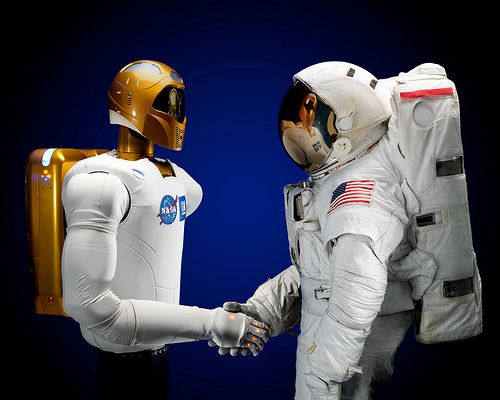 |
| Robonaut 2 |
In addition humans require a great deal of preparation and equipment in order to perform any kind of duty in space. It is not uncommon for astronauts to spend 2-3 hours gearing up for an 8 hour EVA. In commercial applications this time used to just "get ready for work" is unacceptable and un-maintainable. If a group of construction workers is sent to orbit the company that sponsored them does not want them to spend a third of their workday getting ready to start work.
The simple solution to all of these problems is to replace the humans. Robots can literally live in space without any of the extra amenities that humans need. But robots are continuously limited by their intelligence. While AI is developing it is still far from rivaling the problem-solving that a human can bring to the table. But robots are able to mimic our physical abilities quite well. Therefore the logical solution would be to create robots which are remotely operated by humans. Therefore one ends up with, basically, a robot with the mind of a human, which needs no food, water, or preparation to start work,
Virtual reality has progressed far enough that it is possible for a human to have a completely immersive experience while operating a robot. The controller can see through the eyes of the machine and watch as the robot arms mimic the controller's motions so perfectly that the person can feel as if they are in a suit in space.
This type of telecontrol eliminates for the need for people to go to space at all to perform duties. Thus greatly reducing cost and risk to any company which ventures into this sector. The robots would risk the launch and the environment, the controller would operate from 9 to 5 as if they were in orbit, but then have dinner at home.
Fortuitously, this technology has been an area of study for NASA for some time. Robonaut is essentially all that has just been discussed and is currently operating on the ISS in a limited capacity. Much of this research is in the public domain and could be utilized by a start-up wishing to develop a telepresence astronaut to fill the stated needs.
 |
| The Personal Satellite Assistant. A small space robot |
As the need for human workers or equivalents grows, with the advent of space stations and interplanetary craft, more advanced robots can be created. These could begin service as emergency responders and maintenance workers where time for human preparation is not available. This time advantage will be something any company would be able to flaunt around. If a space station develops a fault which must quickly be repaired from the outside which would one rather have? A human who needs two hours to get to the problem or a robot which needs two minutes.
Concerning business structure, such robots would likely be deployed on a rental basis. A space station being constructed could use one for assembly and inspection and when finished the robots would migrate to the next job. Since it needs no food or life support the machine could literally float in orbit for years waiting for the next job. When the emergency benefits of such robots are realized many will be purchased and installed permanently in structures just as one would install a fire extinguisher.
The beauty of such a business is that it is a solution which can be created and then just sit and wait for the demand. A company could send several robots into orbit and have them available when the first private structures are contracted. In the meantime they could be contracted to maintain some satellites and perform checks on existing space vehicles.
Essentially, such a robotics firm would likely begin as an orbital safety drone provider. Checking ships before they re-enter the atmosphere. Then as the construction industry grows they can develop into telepresence bodies for astronauts who are earth-bound or restricted to their space vehicle.. After that who knows? Machines with men inside could be created that prepare colony sites for human occupation.
A market exists now for such space safety drones. If they had existed earlier the Columbia accident could have been avoided. And since a robot is cheaper to send to space than a human the market for a telepresence astronaut will come and grow.
It is a sector with a proven need and proven technology. All the ground work has been laid by other entities, it simply needs to be turned into a business. And until launch costs come far down and human equipment develops much further this will be an integral service in the space industry.

This comment has been removed by a blog administrator.
ReplyDelete